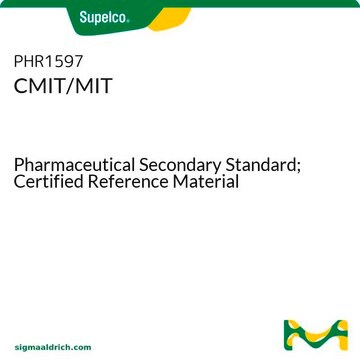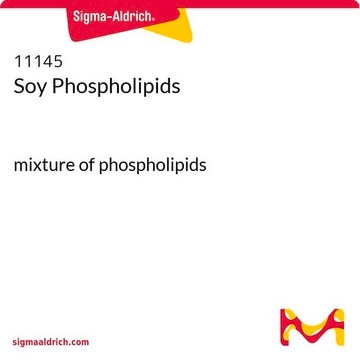おすすめの製品
アッセイ
≥94.0% (GC)
95%
形状
lumps
不純物
≤5% water
SMILES記法
CN1SC=CC1=O
InChI
1S/C4H5NOS/c1-5-4(6)2-3-7-5/h2-3H,1H3
InChI Key
BEGLCMHJXHIJLR-UHFFFAOYSA-N
類似した製品をお探しですか? 訪問 製品比較ガイド
アプリケーション
- Insights into the mechanisms of within-species variation in sensitivity to chemicals: A case study using daphnids exposed to CMIT/MIT biocide.:この研究では、ミジンコの2-メチル-4-イソチアゾリン-3-オンに対する感受性の相違を調査し、これらの差異の根底にある生物化学的機構を示しています。研究結果は、環境安全アセスメントに不可欠な知見を提供しています(Kim et al., 2023)。
- Effects of the biocide methylisothiazolinone on Xenopus laevis wound healing and tail regeneration.:この研究では、両生類の再生プロセスに対する2-メチル-4-イソチアゾリン-3-オンの影響を評価し、その生物学的効果および潜在的毒性の理解に貢献しています(Delos Santos et al., 2016)。
- T cell lymphomatoid contact dermatitis: a challenging case and review of the literature.:この概説では、2-メチル-4-イソチアゾリン-3-オン誘発接触皮膚炎についての議論を扱い、皮膚科学的用途および安全性評価に関する貴重な情報を提供しています(Knackstedt and Zug, 2015)。
シグナルワード
Danger
危険有害性の分類
Acute Tox. 2 Inhalation - Acute Tox. 3 Dermal - Acute Tox. 3 Oral - Aquatic Acute 1 - Aquatic Chronic 1 - Eye Dam. 1 - Skin Corr. 1B - Skin Sens. 1A
補足的ハザード
保管分類コード
6.1A - Combustible acute toxic Cat. 1 and 2 / very toxic hazardous materials
WGK
WGK 3
引火点(°F)
Not applicable
引火点(℃)
Not applicable
個人用保護具 (PPE)
dust mask type N95 (US), Eyeshields, Faceshields, Gloves, type P3 (EN 143) respirator cartridges
適用法令
試験研究用途を考慮した関連法令を主に挙げております。化学物質以外については、一部の情報のみ提供しています。 製品を安全かつ合法的に使用することは、使用者の義務です。最新情報により修正される場合があります。WEBの反映には時間を要することがあるため、適宜SDSをご参照ください。
Jan Code
725765-25G:
725765-BULK:
725765-VAR:
725765-5G:
試験成績書(COA)
製品のロット番号・バッチ番号を入力して、試験成績書(COA) を検索できます。ロット番号・バッチ番号は、製品ラベルに「Lot」または「Batch」に続いて記載されています。
この製品を見ている人はこちらもチェック
ライフサイエンス、有機合成、材料科学、クロマトグラフィー、分析など、あらゆる分野の研究に経験のあるメンバーがおります。.
製品に関するお問い合わせはこちら(テクニカルサービス)











